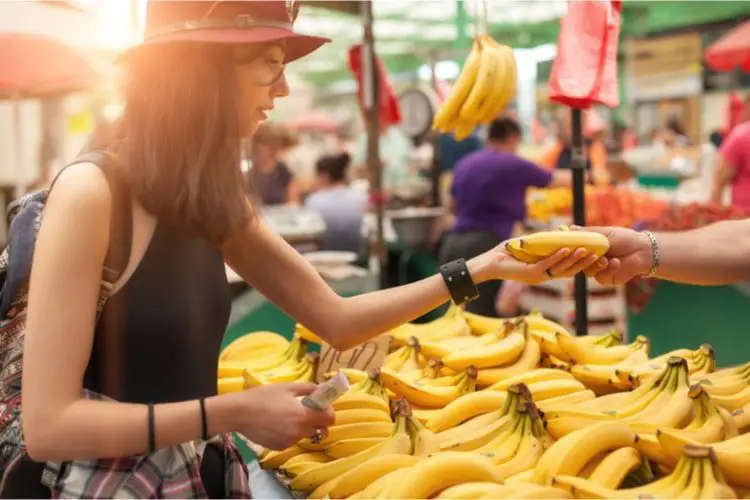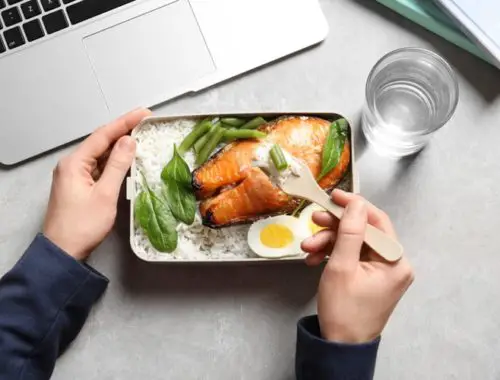In a world that says “eat less” of just about everything, potassium is a nutrient that most of us probably need more of.
Whether you’re just interested in eating healthier or your doctor told you to get more potassium, this article will give you a basic overview.
What is potassium?
Potassium is a mineral in the foods we eat and an electrolyte in our blood. When we eat potassium foods, the body will metabolize the potassium, use what we need and then excrete it as necessary.
It’s potassium’s role to control mineral and fluid balance, maintain blood pressure and help muscles contract, including our heart muscles (1). These are all really important functions!
If you’re healthy, your blood potassium levels will likely stay in a normal range. However, if your potassium gets out of range, there are serious health concerns:
- Abnormal heart rhythm
- Paralysis
- Weakness
- Muscle cramps
- Fatigue
- Constipation
There are certain conditions and situations that can make potassium problematic (2–3):
| Conditions that may lead to high potassium | Conditions that may lead to low potassium |
|---|---|
| Kidney disease (acute, chronic) | Kidney disease (chronic) |
| Dehydration | Chronic diarrhea and/or vomiting |
| Blood pressure medications (i.e. ACE inhibitors, beta blockers, angiotensin II receptor blockers) | Excessive alcohol use |
| Type 1 diabetes | Diuretics, Excessive laxative use, Excessive sweating |
| Severe injury or burns | Diabetic ketoacidosis |
| Improper use of potassium supplements | Antibiotic use |
If you have any of these conditions or take these medications, ask your doctor about how potassium affects your health. You should also be followed by a Registered Dietitian.
How much potassium do I need?
For those with the conditions and medications listed above, your potassium needs may vary from the general public.
However, if you’re otherwise healthy, there are established minimal intakes that you should hit daily.
Adequate Intake (AI) recommendations state the minimum amount of potassium that you need for a “nutritionally adequate” diet (4).
The AI for men over age 19 is 3400mg potassium per day. Women over age 19 should get at least 2600mg potassium per day.
If you’re pregnant, your potassium AI bumps up to at least 2900mg. Lactating women need at least 2800mg per day (4).
How to Get Enough Potassium Every Day
It’s hard to know if you’re getting enough potassium! How can you keep track of how many milligrams you consume?
Luckily, newer Nutrition Facts labels include the amount of potassium per serving! Remember to check if you ate more or less than the suggested serving size.
Otherwise, having a diet full of potassium foods is easier than you think!
In general, fill your plate with fruits, veggies, whole grains, lowfat dairy and plant-based protein.
Potassium-rich foods are typically included in general healthy eating guidelines!
List of Potassium Rich Foods to Include in Your Diet
Let’s highlight some great potassium options to include regularly!
Quick note: Percentages are based on the AI for gender. On current Nutrition Facts labels, you may notice some discrepancies since potassium labeling is changing in 2020 and 2021.
#1: Bananas
Many people think of bananas when they think of potassium. Bananas are a great place to start!
They are full of vitamins and fiber, and can be used as a healthy substitute in baked goods and desserts. Also, you can just eat them as fresh fruit!
I love having sliced banana on nonfat Greek yogurt with a touch of cinnamon and honey.
1 medium banana contains 422mg of potassium (4). That’s 12% of men’s AI and 16% of women’s AI.
#2: Dried Apricots
Dried apricots are an excellent source of potassium! I love these Turkish Dried Apricots the most. They’re shelf stable and great for topping yogurt, oatmeal and salads. Dip them in some dark chocolate (see why in #5), and they make a really tasty dessert.
A ½ cup of dried apricots has 1101mg of potassium (4). Wow! That’s 32% of men’s AI and 42% of women’s AI.
#3: Legumes
Beans, lentils and other legumes are great ways to get potassium. Plus, they’re full of healthy plant-based protein and fiber.
According to the American Heart Association, these plant-based protein sources may improve cholesterol. Try to include legumes in your diet often.
I always keep edamame beans in my kitchen. You can get plain, frozen edamame or dry roasted, crunchy edamame for snacking. They go great in nearly any meal: pasta dishes, stir fry, soup, casseroles, salads.
For snacking and garnishes, I like Seapoint Farms Edamame.
1/3 cup of dried edamame has 530mg of potassium. That’s 16% of men’s AI and 20% of women’s AI.
#4: Milk
You may know that milk is a great way to get calcium in the diet, but did you know it’s also full of potassium?
Milk provides calcium, protein and potassium. However, make sure you opt for lowfat milk (skim, 1% or 2%) so that you can keep the calories and unhealthy saturated fats in check.
1 cup of 1% milk has 366mg of potassium. That’s 11% of men’s AI and 14% of women’s AI.
#5: Dark Chocolate
If you want dessert but you also want to increase your potassium, then reach for some dark chocolate!
Dark chocolate contains antioxidants and potassium. Try to get dark chocolate that has the highest amount of unsweetened cocoa and the least amount of sugar.
In general, the higher the percentage of cocoa, the more nutrient benefits. Try dark chocolate that is 70% unsweetened cocoa or higher like Green & Black’s Organic Dark Chocolate.
But remember: Always control your portions!
1 ounce of 70-85% dark chocolate contains 203mg of potassium (5). That’s 6% of men’s AI and 8% of women’s AI. Pretty good for a dessert!
#6: Green Leafies
Dark green leafy vegetables are another great way to get potassium. Spinach and Swiss chard are just a few green leafies that you should include regularly.
Instead of pale lettuce, you can drastically up the nutrients by switching to dark greens more often. Eat raw green leafies as a salad or sauté them and add them to pasta, casseroles and soups.
A 3-cup spinach salad contains 475mg potassium. That’s 14% of men’s AI and 18% of women’s AI.
The Bottom Line
Above all, eating a healthy diet of fruits, veggies, plant-based protein and lowfat dairy will allow most people to meet their potassium AI.
You can even combine these potassium foods like we mentioned: dried apricots dipped in dark chocolate or a spinach salad with a roasted edamame garnish.
There’s a long list of potassium foods, and luckily, most are very healthy to consume.
As a reminder: Check with your healthcare team if you have underlying health conditions that affect your potassium levels.



